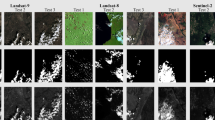Abstract
A novel nonlinear gray transform method is proposed to enhance the contrast of a typhoon cloud image. Generally, the typhoon cloud image obtained by a satellite cannot be directly used to make an accurate prediction of the typhoon’s center or intensity because the contrast of the received typhoon cloud image may be bad. Our aim is to extrude the typhoon’s eye in the typhoon cloud image. A normalized arc-tangent transformation operation is designed to enhance global contrast of the typhoon cloud image. Differential evolution algorithm is used to choose the optimal nonlinear transform parameter. Finally, geodesic activity contour model is used to extract the typhoon’s eye to verify the performance of the proposed method. Experimental results show that the proposed method can efficiently enhance the global contrast of the typhoon cloud image while greatly extruding the typhoon’s eye.
Similar content being viewed by others
Explore related subjects
Discover the latest articles and news from researchers in related subjects, suggested using machine learning.References
J. Albertz, K. Zelianeos. Enhancement of satellite image data by data cumulation. ISPRS Journal of Photogrammetry and Remote Sensing, vol. 45, no. 3, pp. 161–174, 1990.
K. G. Karantzalos. Combining anisotropic diffusion and alternating sequential filtering for satellite image enhancement and smoothing. In Proceedings of SPIE — Image and Signal Processing for Remote Sensing IX, Barcelona, Spain, vol. 5238, pp. 461–468, 2004.
B. Attachoo, P. Pattanasethanon. A new approach for colored satellite image enhancement. In Proceedings of IEEE International Conference on Robotics and Biomimetics, IEEE, Bangkok, Thailand, pp. 1365–1370, 2009.
C. J. Zhang, J. Lu. Satellite cloud image enhancement by genetic algorithm with fuzzy technique. In Proceedings of International Conference on New Trends in Information and Service Science, Beijing, PRC, pp. 1090–1095, 2009.
B. P. Pfaff, D. Baker, L. G. Allred, G. Ware. Temporal change enhancement in multispectral images remotely sensed from satellites. In Proceedings of the SPIE — Visual Information Processing VI, SPIE, Orlando, USA, vol. 3074, pp. 104–108, 1997.
I. Tamches, N. J. Belknap. Development of Digital Enhancement Techniques Applicable to Direct Read-out (APT) Meteorological Satellite Images, Technical Report, USA, 1973.
G. Xu, J. Su, H. D. Pan, Z. G. Zhang, H. B. Gong. An image enhancement method based on gamma correction. In Proceedings of the 2nd International Symposium on Computational Intelligence and Design, IEEE, Changsha, PRC, pp. 60–63, 2009.
J. F. Yang, Y. H. Shi, X. L. Xiong. Improved gamma correction method in weakening illumination. Journal of Civil Aviation University of China, vol. 24, no. 4, pp. 39–42, 2006. (in Chinese)
S. M. Zhou, J. Q. Gan, L. D. Xu, R. John. Interactive image enhancement by fuzzy relaxation. International Journal of Automation and Computing, vol. 4, no. 3, pp. 229–235, 2007.
G. Sahoo, T. Kumar, B. L. Raina, C. M. Bhatia. Text extraction and enhancement of binary images using cellular automata. International Journal of Automation and Computing, vol. 6, no. 3, pp. 254–260, 2009.
H. Demirel, G. Anbarjafari. Satellite image resolution enhancement using complex wavelet transform. IEEE Geoscience and Remote Sensing Letters, vol. 7, no. 1, pp. 123–126, 2010.
H. Demirel, C. Ozcinar, G. Anbarjafari. Satellite image contrast enhancement using discrete wavelet transform and singular value decomposition. IEEE Geoscience and Remote Sensing Letters, vol. 7, no. 2, pp. 333–337, 2010.
C. J. Zhang, X. D. Wang. Typhoon cloud image enhancement and reducing speckle with genetic algorithm in stationary wavelet domain. IET Image Processing, vol. 3, no. 4, pp. 200–216, 2009.
R. Storn, K. Price. Differential Evolution — A simple and Efficient Adaptive Scheme for Global Optimization over Continuous Spaces, Technical Report TR-95-012, Berkely, USA, 1995.
V. Caselles, R. Kimmel, G. Sapiro. Geodesic active contours. International Journal of Computer Vision, vol. 22, no. 1, pp. 61–79, 1997.
Author information
Authors and Affiliations
Corresponding author
Additional information
This work was supported by National Natural Science Foundation of China (No. 40805048, No. 11026226), Typhoon Research Foundation of Shanghai Typhoon Institute/China Meteorological Administration (No. 2008ST01), Research Foundation of State Key Laboratory of Remote Sensing Science, Jointly sponsored by the Institute of Remote Sensing Applications of Chinese Academy of Sciences and Beijing Normal University (No. 2009KFJJ013), Research Foundation of State Key Laboratory of SevereWeather/Chinese Academy of Meteorological Sciences (No. 2008LASW-B03).
Chang-Jiang Zhang received the Ph.D. degree in control theory and control engineering from Beijing Institute of Technology, Beijing, PRC in 2004. He joined the Department of Electronic Information and Engineering, Zhejiang Normal University, Zhejiang, PRC in 2004. He is currently an professor in the Department of Signal and Information Processing at the Zhejiang Normal University, where he is the head of the Image and Graphic Processing Group. He is currently a member of China Society of Image Graphics and Chinese Meteorological Society.
His research interests include image processing, remote sensing, wavelet transform, multi-scale geometry analysis, and machine learning.
Bo Yang received the bachelor degree in electronics and information engineering from Zhejiang Normal University, Zhejiang, PRC in 2008. He is now a master student at the Zhejiang Normal University.
His research includes image segmentation, image enhancement, support vector machine, and wavelet transform.
Rights and permissions
About this article
Cite this article
Zhang, CJ., Yang, B. A novel nonlinear algorithm for typhoon cloud image enhancement. Int. J. Autom. Comput. 8, 161–169 (2011). https://doi.org/10.1007/s11633-011-0569-1
Received:
Revised:
Published:
Issue Date:
DOI: https://doi.org/10.1007/s11633-011-0569-1




